Table of contents
- Screwdriver tip: retreading wheels So that everything runs smoothly
- Types
- Control is better
- The air pressure
- Tire age
- Tire cover and assembly
- Do it yourself
- Roadside assistance
- Mechanic courses

Ralf Petersen
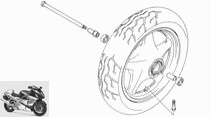
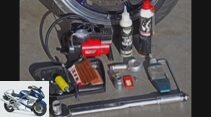
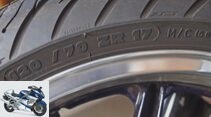
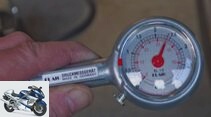
15th pictures

Suzuki
1/15
So that everything runs smoothly. The screwdriver tip for everything to do with bikes.
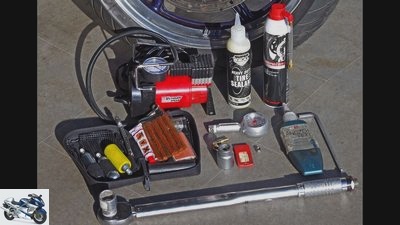
Ralf Petersen
2/15
What you need: Pump or compressor, torque wrench and suitable sockets, grease, repair kit for tubeless tires, breakdown spray, tire milk, air pressure gauge and angle adapter.
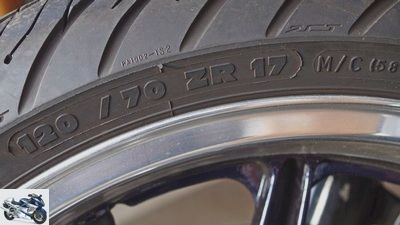
Ralf Petersen
3/15
/ 1 / All important information is on the tire wall.
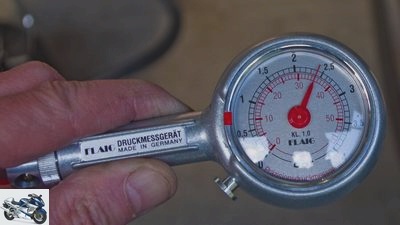
Ralf Petersen
4/15
/ 2 / Check tire pressure with a high-quality measuring device.
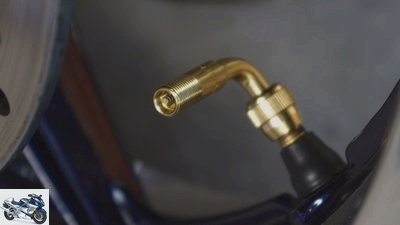
Ralf Petersen
5/15
/ 3 / Tip for the tool kit: 90-degree valve extension.
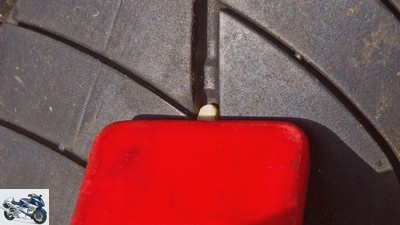
Ralf Petersen
6/15
/ 4 / Measure tread depth? Ideally next to the TWI indicators.
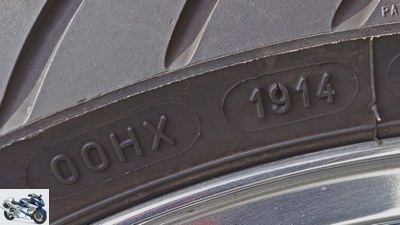
Ralf Petersen
7/15
/ 5 / Age information: The DOT number reveals the production date.

Ralf Petersen
8/15
/ 6 / Protection from UV light: tires that are well covered age more slowly.

Ralf Petersen
9/15
/ 7 / Balancing aid: The assembly point belongs at valve height.
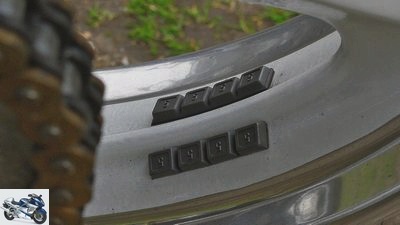
Ralf Petersen
10/15
/ 8 / Badly balanced tires cause unrest in the chassis.
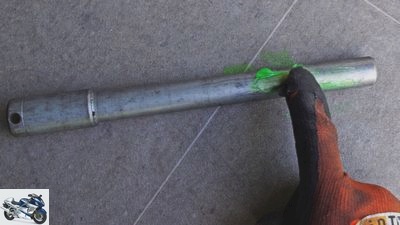
Ralf Petersen
11/15
/ 9 / Lightly grease the quick release axle when installing the wheel.

Ralf Petersen
12/15
/ 10 / Only tighten the quick-release axle with the specified torque.
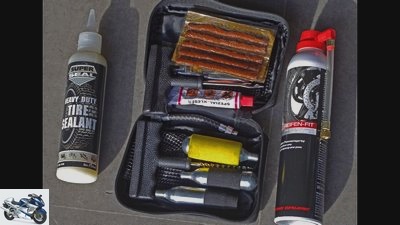
Ralf Petersen
13/15
/ 11 / Emergency kit: breakdown assistance with spray and repair kit.

Ralf Petersen
14/15
/ 12 / Better to train once: patch a tubeless tire.

Ralf Petersen
15/15
Ralf Petersen. The author works as a further education teacher at the VHS Duisburg and has been organizing mechanics courses for over 20 years. 12 to 15 practical seminars on maintenance, repair and technology are offered every year.
counselor
workshop
Screwdriver tip: retreading wheels
Screwdriver tip: retreading wheels
So that everything runs smoothly
Let’s be honest, when was the last time you took a close look at the wheels of your motorcycle: checked the rims and their balancing weights, checked the tires and tread depths, checked the air pressure? Use the start of the season for a complete renovation.
Ralf Petersen
07.12.2017
Motorcycle tires are all-rounders. They ensure the (survival) important contact between the vehicle and the road, transmit acceleration, braking and cornering forces and, thanks to their damping properties, increase driving comfort. In order to be able to cope with their diverse tasks, tires must be checked and changed regularly.
Buy complete article
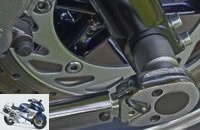
Screwdriver tip: retreading wheels
So that everything runs smoothly
4 pages) as PDF
€ 2.00
Buy now
\ n<div class = \&# 34; v-A_-custom-html v-A_-custom-html – video \ “>\ n<iframe width = \&# 34; 578 \&# 34; height = \&# 34; 325 \&# 34; src = \&# 34; https: //www.youtube.com/embed/s9rTT8cT1sw \&# 34; frameborder = \&# 34; 0 \&# 34; allow = \&# 34; autoplay; encrypted-media \&# 34; allowfullscreen></ iframe>\ n</ div>\ n</ div>\ n&# 34;,&# 34; consentGroup&# 34;: null}”>
Types
Whether sports, touring, racing or enduro tires, the selection is large and sometimes confusing. Orientation aid is available – in addition to the regular MOTORRAD tire tests on the Internet (www.motorradonline.de/reifentest) – often also in the appropriate Internet forum for the machine. Of course, the intended use (e.g. touring or racetrack) and driving style play an important role. When choosing tires, it is essential to consider the permissible tire sizes (width, load capacity, speed index, etc.) and any tire binding prescribed for the motorcycle, which can, however, be avoided by a clearance certificate from the tire manufacturer. A distinction is also made between tubeless tires and those with a tube, which are mainly used on classic spoked wheels.
Control is better
Regardless of the type and design, it is important to keep a close eye on all tires. Investigations z. B. the Dekra show that in the case of defects that can be proven to lead to accidents, the tires are in first place in the statistics. In addition to the lack of tread depth, incorrect air pressure and the age of the tire or damage played a major role.
The air pressure
Although there are no legally binding regulations for the correct air pressure, the manufacturer’s recommendations (driver’s manual!) Usually offer the highest level of safety and should be adhered to. If you lower the air pressure for sporty use, you gain grip thanks to the larger contact surface. However, the tire can then become too hot as a result of increased flexing, and in the worst case even be damaged, and the vehicle’s consumption also increases. A difference of just 0.2 bar is noticeable. Excessive air pressure leads to increased wear and tear and poorer tire grip. Since the load capacity of a tire increases with the air pressure, it is adjusted accordingly when it is loaded.
Since many bikers underestimate the importance of the correct air pressure, they neglect the important regular checks (preferably every two weeks). The blind trust in the pressure gauges used, which sometimes work imprecisely, is also worrying. A sensible, high-quality air pressure tester (e.g. from Flaig, available from Polo for around 30 euros) is therefore recommended. Very important: The air pressure is always checked when it is cold. If it heats up while driving, it increases by 0.1 to 0.2 bar, so you should check it before starting your journey or take the difference into account. With the air pressure gauges used at petrol stations, it is not always possible to get to the valve properly. A practical valve extension (belongs in the vehicle tool kit) then does a good job. The valve caps should be made of steel and provided with a seal. This means that no air escapes at very high speeds. The tire is also checked for cracks, foreign bodies and other damage, as well as for lost balance weights. Tread depth: Tire wear depends on the type of tire. A racing tire with an extremely soft rubber compound has excellent grip properties, but is often exhausted after less than 1000 km. Touring tires, on the other hand, often last more than 10,000 kilometers. The personal driving style also influences wear and tear, e.g. B. by constant extreme acceleration and braking. The legally prescribed minimum tread depth is 1.6 mm, but a motorcycle tire can already lose its handling characteristics at 3 mm, and it should never have less than 2 mm of residual tread. A simple tread depth gauge is sufficient for measuring, if necessary a one-euro piece with a gold rim of 3 mm can also be used. Modern tires often no longer have a central groove. You then have wear indicators, so-called TWI. These web-like elevations, which are integrated in the longitudinal grooves of the tires, are usually indicated by triangular-like arrow markings on the tire edge. The bars are often only 0.8 mm high (American standard), but if you measure right next to them, you are on the safe side. Even if the profile is still okay, a change may be inevitable due to uneven wear or angular tires as well as damage to the tire sidewall.
Tire age
Regardless of the driving or idle times, the rubber of a tire hardens over the years and increasingly loses its adhesion properties. So you should always try to get a new tire as possible. Almost all manufacturers indicate a period of around six years as the maximum age for motorcycle tires. Curiously, from a legal point of view, a brand-new, properly stored tire is still considered new five years after it was manufactured. You can tell the age of a tire by the DOT number on the tire wall. DOT 1914 means that the tire was produced in the 19th calendar week of 2014. But be careful: UV light, ozone pollution, moisture and heat have a considerable negative impact on the performance of a tire. If the machine is often in the sun, is on the road in all weathers, or if the tires are not relieved during long periods of time, they age faster. Lantern parkers should therefore ensure that a tarpaulin is large enough to completely cover the tires.
Tire cover and assembly
A new tire can be obtained either online or directly from the tire dealer. The question of assembly remains. Fitting and balancing a modern motorcycle tire is quite demanding, requires not only skill and experience, but also the right tools, balancing device, etc. and would be a separate topic for a screwdriver tip. The majority of motorcyclists will go to a tire service or a workshop and in some cases will not do the wheel removal themselves. When buying tires over the Internet, a workshop near your home is usually arranged as a service for tire fitting. For me in Duisburg, however, only a motorcycle workshop was suggested, the rest were normal tire services that are not always very familiar with motorcycles.
During my mechanic courses I unfortunately have to find out again and again that an alarming number of motorcycles (almost every tenth machine!) Are on the road with incorrectly fitted or incorrectly balanced tires. It’s actually quite simple. If the tire is correctly fitted, the direction indicator points in the direction of travel and the fitting point (if present) is on the valve. You should be familiar with both of these requirements and, when picking up the bikes, check them directly before paying. If the rim has no marking for the running direction, I stick a piece of masking tape with a running direction arrow on the rim to be on the safe side. The fitter also recognizes the experienced customer and will (hopefully) work carefully.
A chapter of its own is the important, correct balancing of the wheel (see MOTORCYCLE 13/2017). A typical indication of incorrect assembly are excessive balancing weights on the rim. Most tires have a so-called mounting point (red or yellow marking), which must be mounted so that it is flush with the valve. At this point, the tire is structurally lighter and the weight of the valve is compensated for. If the tire is mounted incorrectly, however, then in most cases considerably more balancing weights have to be applied to compensate for this than is actually necessary, and above all the wheel is not well balanced. This is not a trivial matter, because even small imbalances cause considerable unrest in the chassis and damage the tires and the machine.
So if the assembly of the tires is apparently carried out far too often carelessly, then of course the question arises whether one should leave the installation / removal of the wheels to a tire service (mostly specialized in cars).
Do it yourself
The installation and removal of the wheel is no witchcraft. Those who install / remove their bikes themselves not only save money, but can also take the opportunity to do maintenance work at the same time. This includes greasing the quick-release axle, cleaning and lubricating the speedometer drive (if mechanical), checking the wheel bearings for rust and correct function, and checking the pistons and pads of the brake. It is important that the motorcycle is stable and high enough to be able to remove the bike. If the axle is jammed, it is carefully loosened (rubber mallet). When installing, make sure to tighten them to the correct torque and check the chain tension and wheel alignment after installing a rear wheel.
First ride – risk of slipping! Due to the manufacturing process, new tires are covered with a separating layer and are therefore extremely slippery. Caution is therefore advisable for the first 200 to 300 km.
Roadside assistance
A flat tire, especially on a tour far away from home, can be a real nuisance. Breakdown kits help here (only as an emergency repair!). The simplest and cheapest way of repairing small damages without dismantling the tires is to use a puncture spray (e.g. tire fit, at Polo for around ten euros), which is suitable for both tubeless and tubed tires. If the hole is larger, there is a special repair kit for tubeless tires with plugs, glue and compressed air cylinders. I’ve had very good experiences with this on touring, but this repair requires a certain amount of practice. If you remove the bike yourself, now would be the perfect moment for a training session on the old tire: make a hole and mend it – after the third or fourth time it will definitely work. In the case of tubular tires, you can possibly patch the tube, but you have to dismantle the tire. Hardly possible without tools and experience.
The last option, which leaves quite a mess on the rim, is tire milk, a kind of liquid vulcanizing agent. However, the valve must be unscrewed for filling (suitable extractors are available as valve caps!). With all variants, one should note that the materials age. I therefore replace stoppers, glue and sealant after three years at the latest.
Mechanic courses

Ralf Petersen
Ralf Petersen.
The author works as a further education teacher at the VHS Duisburg and has been organizing mechanics courses for over 20 years. 12 to 15 practical seminars on maintenance, repair and technology are offered every year. In 2015 his book “Basiswissen Motorrad-Technik” was published by Delius Klasing-Verlag. Info: www.motorrad-schrauberkurse.de Facebook: Motorrad-Technik Petersen
Related articles
-
Workshop – screwdriver tip for the inspection
Ralf Petersen 15th pictures Ralf Petersen 1/15 Every motorcycle must be serviced regularly if it is to function properly. Ralf Petersen 2/15 What is…
-
Screwdriver tip – care and inspection of the suspension struts
Photo: Ralf Petersen 14th pictures Ralf Petersen 1/14 1: Classic, beautiful and easy to adjust: stereo shock absorbers. Ralf Petersen 2/14 2: Efficient -…
-
archive 17th pictures archive 1/17 Axle, spokes, rim – the wheel is ready. However, motorcycles, and especially fast sports motorcycles, place high…
-
Screwdriver tips for motorcycle seats
Ralf Petersen 13th pictures Ralf Petersen 1/13 Ralf Petersen 2/13 Ralf Petersen 3/13 Ralf Petersen 4/13 Ralf Petersen 5/13 Ralf Petersen 6/13 Ralf…
-
Screwdriver tip oil change and oil level check
Photo: mps photo studio 14th pictures Honda 1/14 Screwdriver tip – oil change and oil level check. Ralf Petersen 2/14 Preparation: All of this is needed….
-
Basic screwdriver tip for the 1st tool collection
Ralf Petersen 13th pictures Ralf Petersen 1/13 This screwdriver tip is about the most elementary basics. Everyone started out very small and simple. For…
-
Screwdriver tip on the subject of valve control
Ralf Petersen 15th pictures Ralf Petersen 1/15 The valve train controls the gas exchange in a four-stroke engine with the help of the inlet and outlet…
-
Screwdriver tip for the check before the main inspection
Ralf Petersen 14th pictures Ralf Petersen 1/14 Don’t forget: papers, ABEs, tire approvals and a key for the steering lock. Ralf Petersen 2/14 Only with…
-
Herder counselor workshop Screwdriver sins Screwdriver sins It doesn’t work like that Screwing is not rocket science, everything can be learned. But you…
-
Screwdriver tip – preparations for the motorcycle vacation tour
Petersen counselor workshop Screwdriver tip – preparations for the motorcycle vacation tour Screwdriver tip – preparations for the motorcycle vacation…